SOUTHERN CALIFORNIA GOURD RATTLE CONSTRUCTION
By Roy Cook
Tipai Gourd Rattle
interpretation: Analysis of form and function in current usage.
A gourd or shaker
rattle is an object and even though this activity is goal oriented it
will be better to maintain an attitude of non-objective oriented enthusiasm.
By this I am referring to the greater value of the path or process in
the creative journey and the steps into the culture rather than the final
destination or art object produced.
Look around at other rattles used by other singers and the types of uses
that you desire to associate with. Keep in mind; imitation is the proven
and often best type of cultural flattery. In a group oriented society
individualism has a minimal role. Focus on the role or use or values that
are important to the culture that regularly has rattles as a part of its
expression.
But, before we start we need to accept this as an axiom: Measure twice,
or more, cut once. OK, lets start. Look at the gourd you have selected.
Try to determine the shape and balance of the orb. Visualize the handle
in proportion to the gourd. What proportions do you visualize? Will it
be in balance if it is short, long, narrow, thick, or custom proportions?
What size hole will the cut produce? Will you need to step down from the
plug to fit the hole or vice versa? Shake a rattle for a couple of hours,
non-stop, to determine a handle shape that may feel comfortable to your
hand. We still have not cut the gourd. We are still looking for balance.
If we achieve this focus, whatever we produce will be centered and in
balance. All will be harmonious and still special because we are all special
to the Creator.
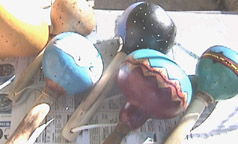 |
Much of the music that is sung in Southern California, Baja and over along the Colorado River utilizes a variety of rattle accompaniments. One of the most familiar varieties is the gourd rattle associated with many of the variations of Bird song presentation. Not too long ago an opportunity became available to experience and receives instruction from a recognized singer on a variety of steps utilized in the construction of the gourd rattle. In appreciation of the detailed teaching and with all due modesty, here are my interpretations. I hope you find them instructive and in this way we will educate and encourage the greater appreciation of the Yuman and other song styles utilizing the gourd rattle. |
In this Southern California area, some singers have their own gardens and grow their own gourds at distance from the other vegetables. Sometimes the garden fencing supports these gourd vines. Realistically and more typically, a trip or inter-net order to Welburn Farms in Fallbrook, California will provide a wide selection of sizes and shapes of dried gourds. In this Tribal workshop, we talked about the former and brought in a big bag of crusty dried gourds from Welburn's. Every student picked out two or three prospective choice shapes and wall thickness. (This size and shape consideration is an area of variation qualified by observation. Also, in time, experience with shape, size and regional determination may motivate you to make other gourds for gifting or useage.)
| First steps: Use a small handsaw to take off the stem portion of the gourd and discard it. We might try to anticipate the sawn opening and the size of the wood handle. But, before I get ahead of myself, the next task is the removal of seeds and the pithy material inside the gourd. There are a variety of creative tools, mostly custom made for this messy task. Spread out lots of newspapers to catch the mess. The cleaner the inside the gourd the clearer the sound of the rattle, take your time. Next you might want to judge the outside carefully and remove some of that crusty stuff until you have a completely clean gourd surface. |  |
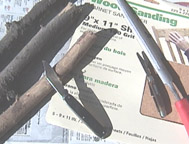 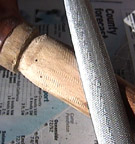 |
While the gourd is boiling this is an excellent time to whittle the handle to a desired shape and size one end to fit snugly in the opening of the gourd. Rasp, knife, drill and lots of sandpaper will be utilized; also this step is real good therapy for anger management and that new twelve-step behavior adjustment program! When both cleaned gourd and handle are ready, bring together for fit, adjust, and refit. |
For the next step we need to add some sound-making elements. Preferred are the traditional date palm seeds, cleaned of sand and other stuff. We hear all kinds of stories about how many seeds and why. But what we were told was to put them in, insert the handle and shake it, if it sounds like too many, remove some, too few, add some, it worked for us.
| Next, the handle needs to be glued (White,
Elmer’s, Carpenters, etc) to the gourd. Tilt the rattle so that none
of the seeds will be glued at the same time. If it is still too loose
it may be necessary to adjust the handle with layers of masking tape
for a snug fit and then glue. Let set, sand, and paint, in the regional
style you are representing, both or more rattles. Keep in mind tribal
generosity, decorate the best one to give away, make up a real good
story to go with it too. Enjoy swinging those gourd rattles and singing
the many styles, (twelve to fourteen) of traditional Southern California
songs. |
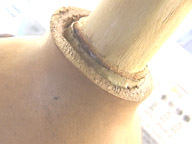 |
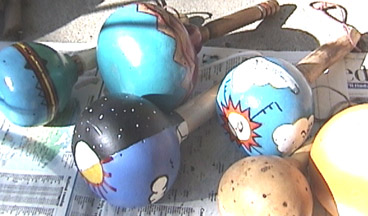 |
Here are some rattles we made and some
are gifts and some are from other areas and looked real interesting.
Sam Brown has other examples of gourds he has made and has been gifted
on his home page. singbird.com
See what you think and let us know your opinions. Have great fun following Native American custom and tradition. All Pictures and WebMaster: Ben Nance |
|
MATERIALS SOURCE |
|

|